HRMG5064: Organisational Behaviour - A Critical Analysis of Articles
VerifiedAdded on 2023/05/29
|18
|5435
|176
Essay
AI Summary
This essay critically analyzes four articles on employee motivation and performance within the context of Organisational Behaviour (OB) and Human Resource Management (HRM). It explores the impact of both intrinsic and extrinsic motivation on employee performance, examining concepts like prosocial motivation, job autonomy, and family motivation. The analysis covers various research methodologies and findings, highlighting the complex relationship between different motivational factors and their influence on employee output and organizational success. The essay also touches upon the role of human resource practices in fostering motivation and improving overall organizational performance. Desklib is a platform where students can find past papers and solved assignments.
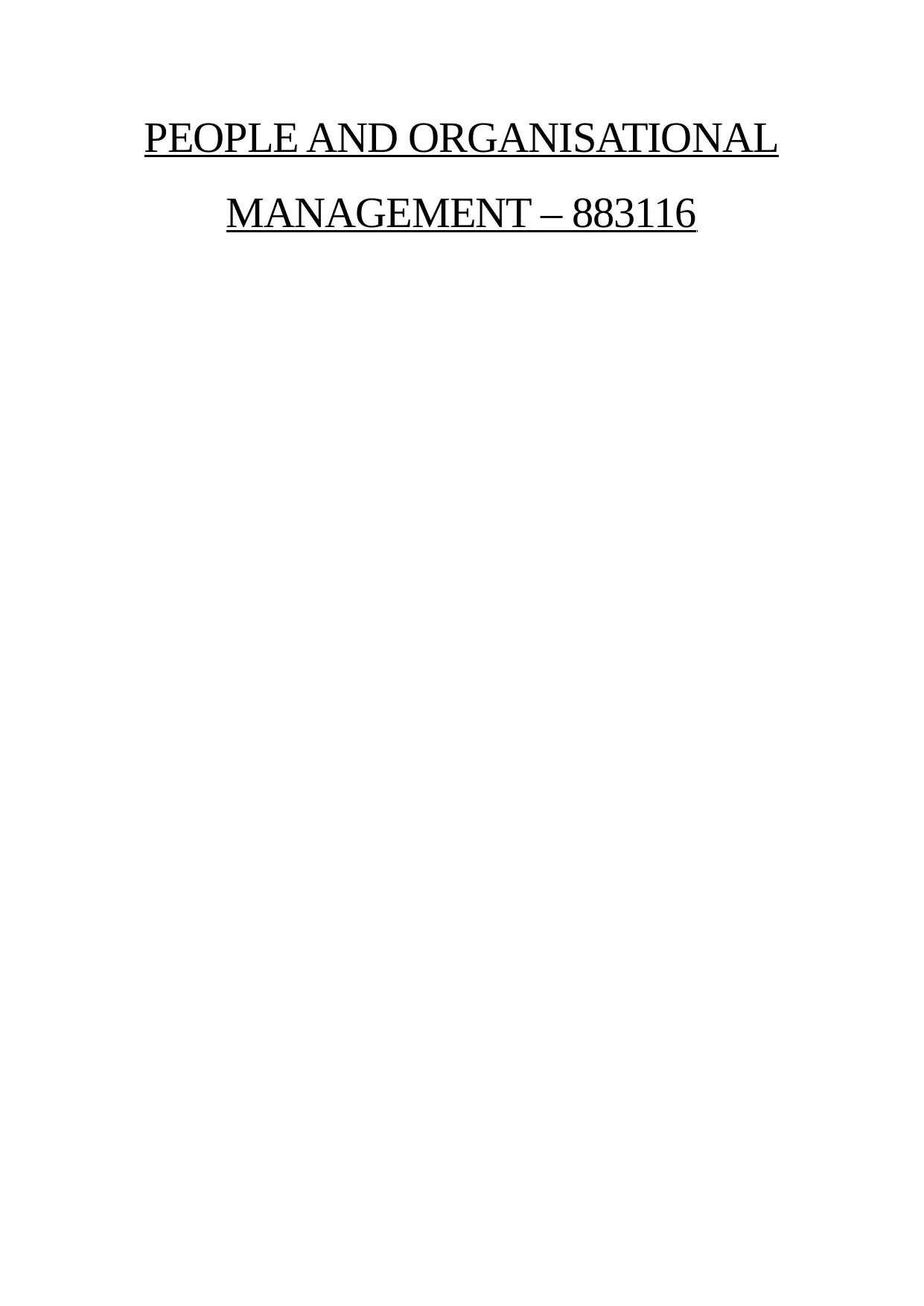
PEOPLE AND ORGANISATIONAL
MANAGEMENT – 883116
MANAGEMENT – 883116
Paraphrase This Document
Need a fresh take? Get an instant paraphrase of this document with our AI Paraphraser
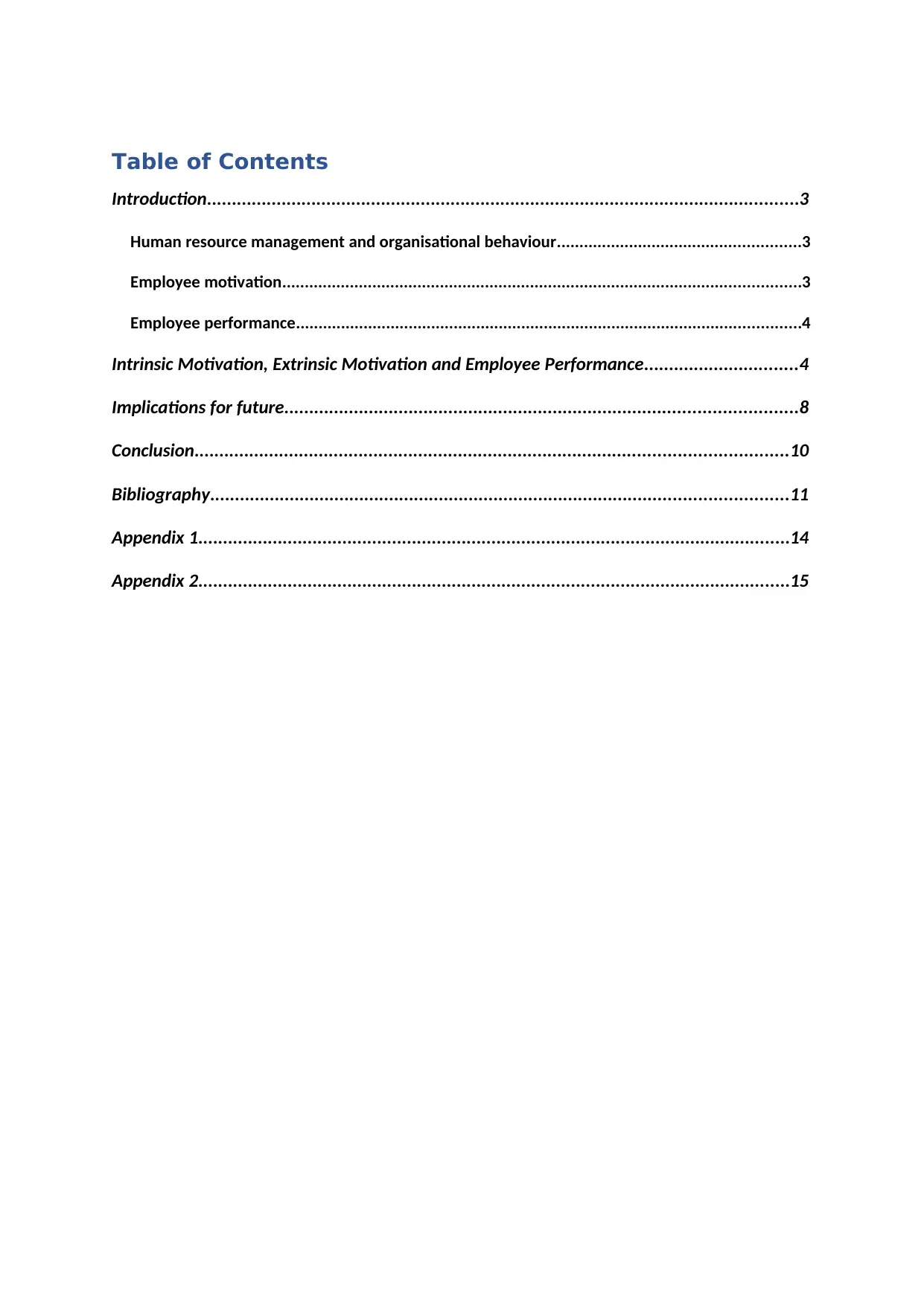
Table of Contents
Introduction.......................................................................................................................3
Human resource management and organisational behaviour......................................................3
Employee motivation...................................................................................................................3
Employee performance................................................................................................................4
Intrinsic Motivation, Extrinsic Motivation and Employee Performance...............................4
Implications for future.......................................................................................................8
Conclusion.......................................................................................................................10
Bibliography....................................................................................................................11
Appendix 1.......................................................................................................................14
Appendix 2.......................................................................................................................15
Introduction.......................................................................................................................3
Human resource management and organisational behaviour......................................................3
Employee motivation...................................................................................................................3
Employee performance................................................................................................................4
Intrinsic Motivation, Extrinsic Motivation and Employee Performance...............................4
Implications for future.......................................................................................................8
Conclusion.......................................................................................................................10
Bibliography....................................................................................................................11
Appendix 1.......................................................................................................................14
Appendix 2.......................................................................................................................15
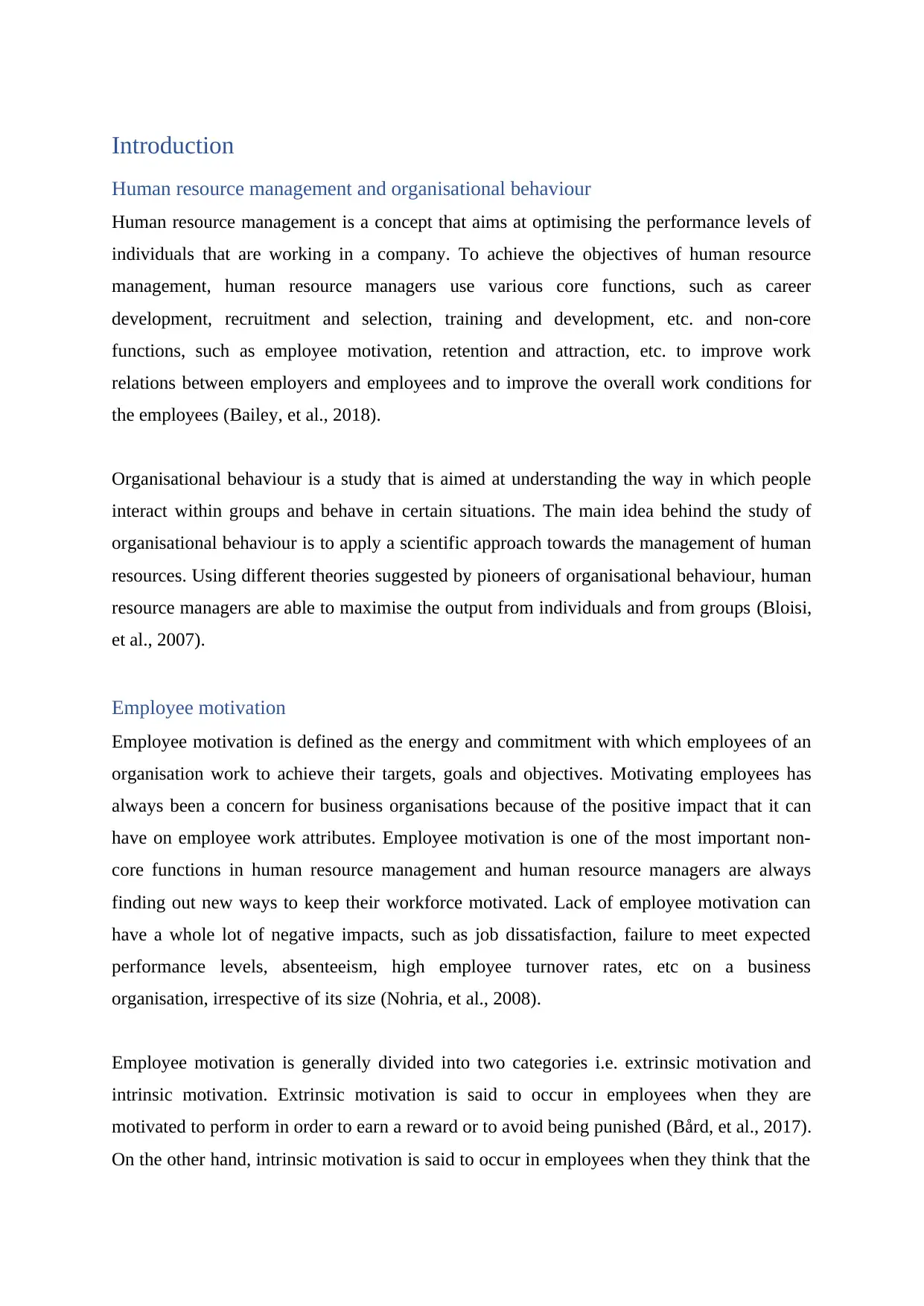
Introduction
Human resource management and organisational behaviour
Human resource management is a concept that aims at optimising the performance levels of
individuals that are working in a company. To achieve the objectives of human resource
management, human resource managers use various core functions, such as career
development, recruitment and selection, training and development, etc. and non-core
functions, such as employee motivation, retention and attraction, etc. to improve work
relations between employers and employees and to improve the overall work conditions for
the employees (Bailey, et al., 2018).
Organisational behaviour is a study that is aimed at understanding the way in which people
interact within groups and behave in certain situations. The main idea behind the study of
organisational behaviour is to apply a scientific approach towards the management of human
resources. Using different theories suggested by pioneers of organisational behaviour, human
resource managers are able to maximise the output from individuals and from groups (Bloisi,
et al., 2007).
Employee motivation
Employee motivation is defined as the energy and commitment with which employees of an
organisation work to achieve their targets, goals and objectives. Motivating employees has
always been a concern for business organisations because of the positive impact that it can
have on employee work attributes. Employee motivation is one of the most important non-
core functions in human resource management and human resource managers are always
finding out new ways to keep their workforce motivated. Lack of employee motivation can
have a whole lot of negative impacts, such as job dissatisfaction, failure to meet expected
performance levels, absenteeism, high employee turnover rates, etc on a business
organisation, irrespective of its size (Nohria, et al., 2008).
Employee motivation is generally divided into two categories i.e. extrinsic motivation and
intrinsic motivation. Extrinsic motivation is said to occur in employees when they are
motivated to perform in order to earn a reward or to avoid being punished (Bård, et al., 2017).
On the other hand, intrinsic motivation is said to occur in employees when they think that the
Human resource management and organisational behaviour
Human resource management is a concept that aims at optimising the performance levels of
individuals that are working in a company. To achieve the objectives of human resource
management, human resource managers use various core functions, such as career
development, recruitment and selection, training and development, etc. and non-core
functions, such as employee motivation, retention and attraction, etc. to improve work
relations between employers and employees and to improve the overall work conditions for
the employees (Bailey, et al., 2018).
Organisational behaviour is a study that is aimed at understanding the way in which people
interact within groups and behave in certain situations. The main idea behind the study of
organisational behaviour is to apply a scientific approach towards the management of human
resources. Using different theories suggested by pioneers of organisational behaviour, human
resource managers are able to maximise the output from individuals and from groups (Bloisi,
et al., 2007).
Employee motivation
Employee motivation is defined as the energy and commitment with which employees of an
organisation work to achieve their targets, goals and objectives. Motivating employees has
always been a concern for business organisations because of the positive impact that it can
have on employee work attributes. Employee motivation is one of the most important non-
core functions in human resource management and human resource managers are always
finding out new ways to keep their workforce motivated. Lack of employee motivation can
have a whole lot of negative impacts, such as job dissatisfaction, failure to meet expected
performance levels, absenteeism, high employee turnover rates, etc on a business
organisation, irrespective of its size (Nohria, et al., 2008).
Employee motivation is generally divided into two categories i.e. extrinsic motivation and
intrinsic motivation. Extrinsic motivation is said to occur in employees when they are
motivated to perform in order to earn a reward or to avoid being punished (Bård, et al., 2017).
On the other hand, intrinsic motivation is said to occur in employees when they think that the
⊘ This is a preview!⊘
Do you want full access?
Subscribe today to unlock all pages.

Trusted by 1+ million students worldwide
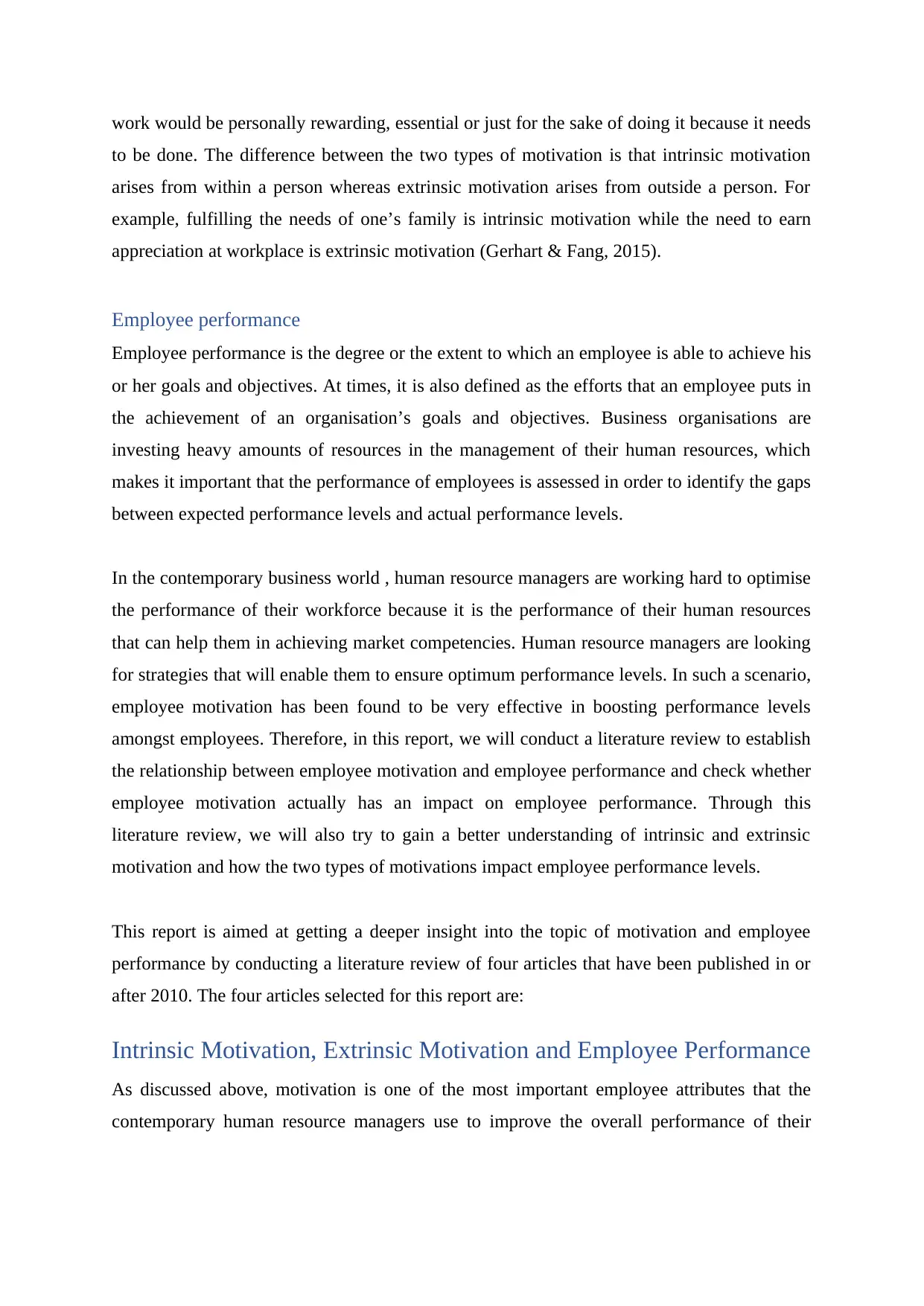
work would be personally rewarding, essential or just for the sake of doing it because it needs
to be done. The difference between the two types of motivation is that intrinsic motivation
arises from within a person whereas extrinsic motivation arises from outside a person. For
example, fulfilling the needs of one’s family is intrinsic motivation while the need to earn
appreciation at workplace is extrinsic motivation (Gerhart & Fang, 2015).
Employee performance
Employee performance is the degree or the extent to which an employee is able to achieve his
or her goals and objectives. At times, it is also defined as the efforts that an employee puts in
the achievement of an organisation’s goals and objectives. Business organisations are
investing heavy amounts of resources in the management of their human resources, which
makes it important that the performance of employees is assessed in order to identify the gaps
between expected performance levels and actual performance levels.
In the contemporary business world , human resource managers are working hard to optimise
the performance of their workforce because it is the performance of their human resources
that can help them in achieving market competencies. Human resource managers are looking
for strategies that will enable them to ensure optimum performance levels. In such a scenario,
employee motivation has been found to be very effective in boosting performance levels
amongst employees. Therefore, in this report, we will conduct a literature review to establish
the relationship between employee motivation and employee performance and check whether
employee motivation actually has an impact on employee performance. Through this
literature review, we will also try to gain a better understanding of intrinsic and extrinsic
motivation and how the two types of motivations impact employee performance levels.
This report is aimed at getting a deeper insight into the topic of motivation and employee
performance by conducting a literature review of four articles that have been published in or
after 2010. The four articles selected for this report are:
Intrinsic Motivation, Extrinsic Motivation and Employee Performance
As discussed above, motivation is one of the most important employee attributes that the
contemporary human resource managers use to improve the overall performance of their
to be done. The difference between the two types of motivation is that intrinsic motivation
arises from within a person whereas extrinsic motivation arises from outside a person. For
example, fulfilling the needs of one’s family is intrinsic motivation while the need to earn
appreciation at workplace is extrinsic motivation (Gerhart & Fang, 2015).
Employee performance
Employee performance is the degree or the extent to which an employee is able to achieve his
or her goals and objectives. At times, it is also defined as the efforts that an employee puts in
the achievement of an organisation’s goals and objectives. Business organisations are
investing heavy amounts of resources in the management of their human resources, which
makes it important that the performance of employees is assessed in order to identify the gaps
between expected performance levels and actual performance levels.
In the contemporary business world , human resource managers are working hard to optimise
the performance of their workforce because it is the performance of their human resources
that can help them in achieving market competencies. Human resource managers are looking
for strategies that will enable them to ensure optimum performance levels. In such a scenario,
employee motivation has been found to be very effective in boosting performance levels
amongst employees. Therefore, in this report, we will conduct a literature review to establish
the relationship between employee motivation and employee performance and check whether
employee motivation actually has an impact on employee performance. Through this
literature review, we will also try to gain a better understanding of intrinsic and extrinsic
motivation and how the two types of motivations impact employee performance levels.
This report is aimed at getting a deeper insight into the topic of motivation and employee
performance by conducting a literature review of four articles that have been published in or
after 2010. The four articles selected for this report are:
Intrinsic Motivation, Extrinsic Motivation and Employee Performance
As discussed above, motivation is one of the most important employee attributes that the
contemporary human resource managers use to improve the overall performance of their
Paraphrase This Document
Need a fresh take? Get an instant paraphrase of this document with our AI Paraphraser
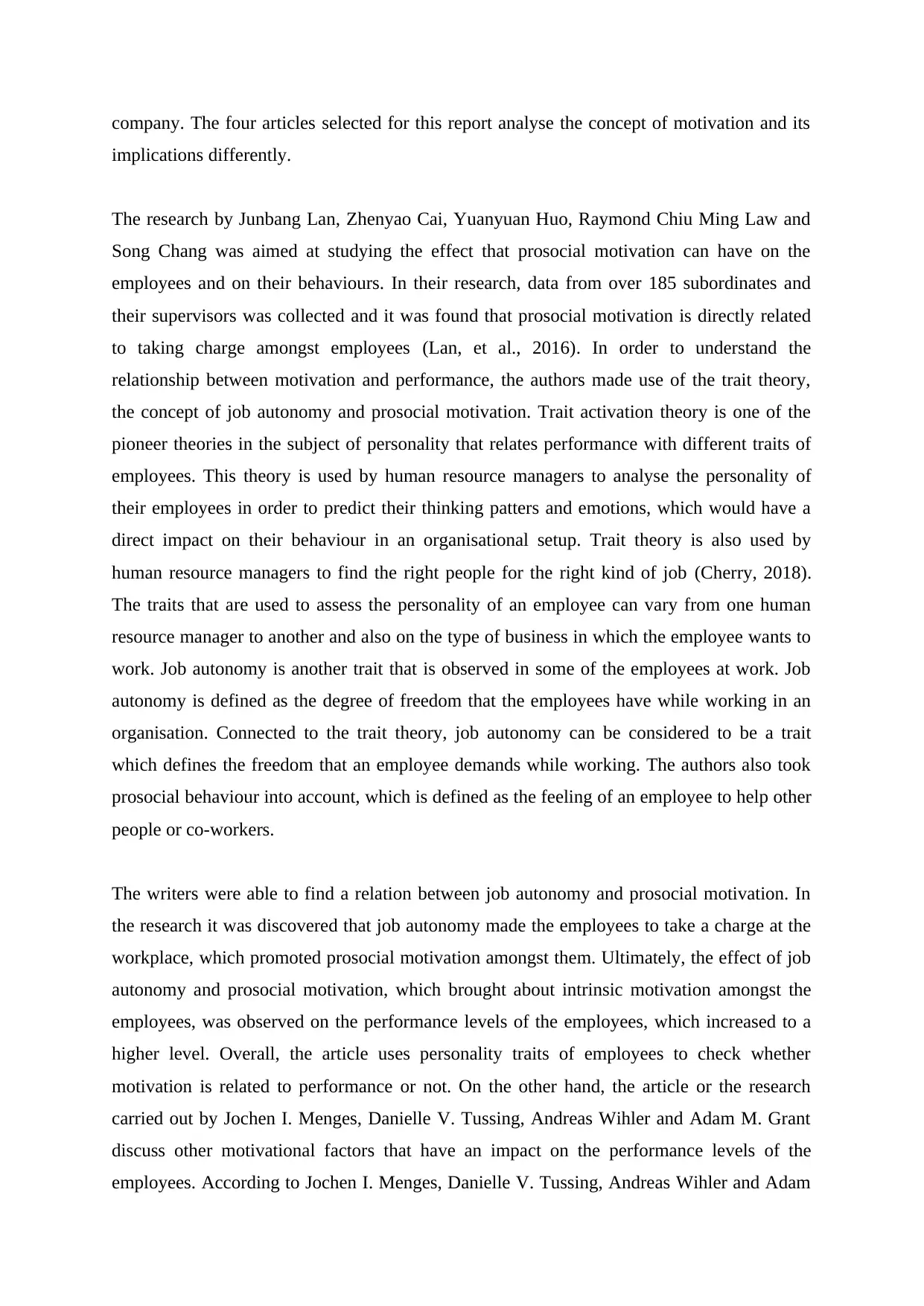
company. The four articles selected for this report analyse the concept of motivation and its
implications differently.
The research by Junbang Lan, Zhenyao Cai, Yuanyuan Huo, Raymond Chiu Ming Law and
Song Chang was aimed at studying the effect that prosocial motivation can have on the
employees and on their behaviours. In their research, data from over 185 subordinates and
their supervisors was collected and it was found that prosocial motivation is directly related
to taking charge amongst employees (Lan, et al., 2016). In order to understand the
relationship between motivation and performance, the authors made use of the trait theory,
the concept of job autonomy and prosocial motivation. Trait activation theory is one of the
pioneer theories in the subject of personality that relates performance with different traits of
employees. This theory is used by human resource managers to analyse the personality of
their employees in order to predict their thinking patters and emotions, which would have a
direct impact on their behaviour in an organisational setup. Trait theory is also used by
human resource managers to find the right people for the right kind of job (Cherry, 2018).
The traits that are used to assess the personality of an employee can vary from one human
resource manager to another and also on the type of business in which the employee wants to
work. Job autonomy is another trait that is observed in some of the employees at work. Job
autonomy is defined as the degree of freedom that the employees have while working in an
organisation. Connected to the trait theory, job autonomy can be considered to be a trait
which defines the freedom that an employee demands while working. The authors also took
prosocial behaviour into account, which is defined as the feeling of an employee to help other
people or co-workers.
The writers were able to find a relation between job autonomy and prosocial motivation. In
the research it was discovered that job autonomy made the employees to take a charge at the
workplace, which promoted prosocial motivation amongst them. Ultimately, the effect of job
autonomy and prosocial motivation, which brought about intrinsic motivation amongst the
employees, was observed on the performance levels of the employees, which increased to a
higher level. Overall, the article uses personality traits of employees to check whether
motivation is related to performance or not. On the other hand, the article or the research
carried out by Jochen I. Menges, Danielle V. Tussing, Andreas Wihler and Adam M. Grant
discuss other motivational factors that have an impact on the performance levels of the
employees. According to Jochen I. Menges, Danielle V. Tussing, Andreas Wihler and Adam
implications differently.
The research by Junbang Lan, Zhenyao Cai, Yuanyuan Huo, Raymond Chiu Ming Law and
Song Chang was aimed at studying the effect that prosocial motivation can have on the
employees and on their behaviours. In their research, data from over 185 subordinates and
their supervisors was collected and it was found that prosocial motivation is directly related
to taking charge amongst employees (Lan, et al., 2016). In order to understand the
relationship between motivation and performance, the authors made use of the trait theory,
the concept of job autonomy and prosocial motivation. Trait activation theory is one of the
pioneer theories in the subject of personality that relates performance with different traits of
employees. This theory is used by human resource managers to analyse the personality of
their employees in order to predict their thinking patters and emotions, which would have a
direct impact on their behaviour in an organisational setup. Trait theory is also used by
human resource managers to find the right people for the right kind of job (Cherry, 2018).
The traits that are used to assess the personality of an employee can vary from one human
resource manager to another and also on the type of business in which the employee wants to
work. Job autonomy is another trait that is observed in some of the employees at work. Job
autonomy is defined as the degree of freedom that the employees have while working in an
organisation. Connected to the trait theory, job autonomy can be considered to be a trait
which defines the freedom that an employee demands while working. The authors also took
prosocial behaviour into account, which is defined as the feeling of an employee to help other
people or co-workers.
The writers were able to find a relation between job autonomy and prosocial motivation. In
the research it was discovered that job autonomy made the employees to take a charge at the
workplace, which promoted prosocial motivation amongst them. Ultimately, the effect of job
autonomy and prosocial motivation, which brought about intrinsic motivation amongst the
employees, was observed on the performance levels of the employees, which increased to a
higher level. Overall, the article uses personality traits of employees to check whether
motivation is related to performance or not. On the other hand, the article or the research
carried out by Jochen I. Menges, Danielle V. Tussing, Andreas Wihler and Adam M. Grant
discuss other motivational factors that have an impact on the performance levels of the
employees. According to Jochen I. Menges, Danielle V. Tussing, Andreas Wihler and Adam
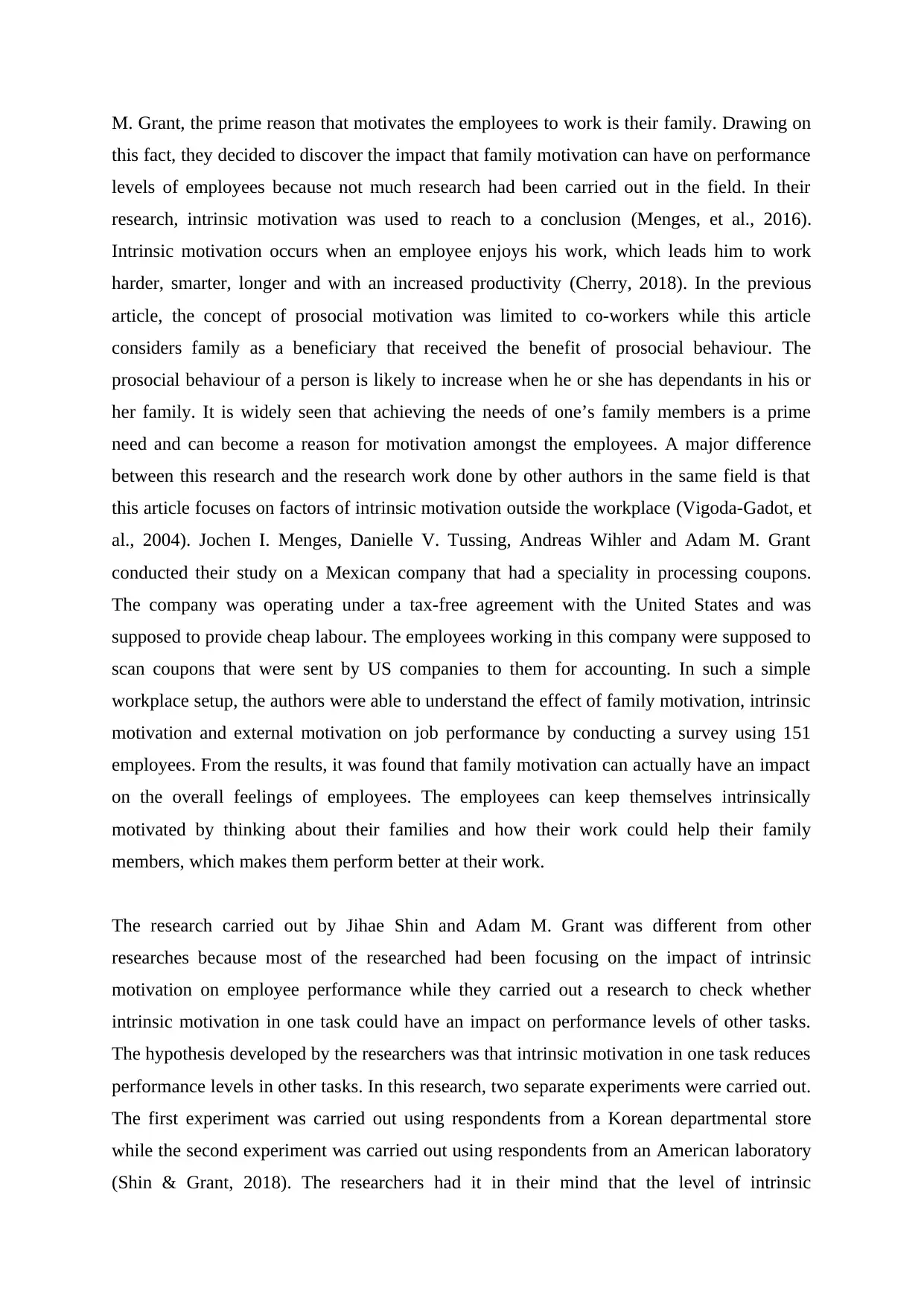
M. Grant, the prime reason that motivates the employees to work is their family. Drawing on
this fact, they decided to discover the impact that family motivation can have on performance
levels of employees because not much research had been carried out in the field. In their
research, intrinsic motivation was used to reach to a conclusion (Menges, et al., 2016).
Intrinsic motivation occurs when an employee enjoys his work, which leads him to work
harder, smarter, longer and with an increased productivity (Cherry, 2018). In the previous
article, the concept of prosocial motivation was limited to co-workers while this article
considers family as a beneficiary that received the benefit of prosocial behaviour. The
prosocial behaviour of a person is likely to increase when he or she has dependants in his or
her family. It is widely seen that achieving the needs of one’s family members is a prime
need and can become a reason for motivation amongst the employees. A major difference
between this research and the research work done by other authors in the same field is that
this article focuses on factors of intrinsic motivation outside the workplace (Vigoda-Gadot, et
al., 2004). Jochen I. Menges, Danielle V. Tussing, Andreas Wihler and Adam M. Grant
conducted their study on a Mexican company that had a speciality in processing coupons.
The company was operating under a tax-free agreement with the United States and was
supposed to provide cheap labour. The employees working in this company were supposed to
scan coupons that were sent by US companies to them for accounting. In such a simple
workplace setup, the authors were able to understand the effect of family motivation, intrinsic
motivation and external motivation on job performance by conducting a survey using 151
employees. From the results, it was found that family motivation can actually have an impact
on the overall feelings of employees. The employees can keep themselves intrinsically
motivated by thinking about their families and how their work could help their family
members, which makes them perform better at their work.
The research carried out by Jihae Shin and Adam M. Grant was different from other
researches because most of the researched had been focusing on the impact of intrinsic
motivation on employee performance while they carried out a research to check whether
intrinsic motivation in one task could have an impact on performance levels of other tasks.
The hypothesis developed by the researchers was that intrinsic motivation in one task reduces
performance levels in other tasks. In this research, two separate experiments were carried out.
The first experiment was carried out using respondents from a Korean departmental store
while the second experiment was carried out using respondents from an American laboratory
(Shin & Grant, 2018). The researchers had it in their mind that the level of intrinsic
this fact, they decided to discover the impact that family motivation can have on performance
levels of employees because not much research had been carried out in the field. In their
research, intrinsic motivation was used to reach to a conclusion (Menges, et al., 2016).
Intrinsic motivation occurs when an employee enjoys his work, which leads him to work
harder, smarter, longer and with an increased productivity (Cherry, 2018). In the previous
article, the concept of prosocial motivation was limited to co-workers while this article
considers family as a beneficiary that received the benefit of prosocial behaviour. The
prosocial behaviour of a person is likely to increase when he or she has dependants in his or
her family. It is widely seen that achieving the needs of one’s family members is a prime
need and can become a reason for motivation amongst the employees. A major difference
between this research and the research work done by other authors in the same field is that
this article focuses on factors of intrinsic motivation outside the workplace (Vigoda-Gadot, et
al., 2004). Jochen I. Menges, Danielle V. Tussing, Andreas Wihler and Adam M. Grant
conducted their study on a Mexican company that had a speciality in processing coupons.
The company was operating under a tax-free agreement with the United States and was
supposed to provide cheap labour. The employees working in this company were supposed to
scan coupons that were sent by US companies to them for accounting. In such a simple
workplace setup, the authors were able to understand the effect of family motivation, intrinsic
motivation and external motivation on job performance by conducting a survey using 151
employees. From the results, it was found that family motivation can actually have an impact
on the overall feelings of employees. The employees can keep themselves intrinsically
motivated by thinking about their families and how their work could help their family
members, which makes them perform better at their work.
The research carried out by Jihae Shin and Adam M. Grant was different from other
researches because most of the researched had been focusing on the impact of intrinsic
motivation on employee performance while they carried out a research to check whether
intrinsic motivation in one task could have an impact on performance levels of other tasks.
The hypothesis developed by the researchers was that intrinsic motivation in one task reduces
performance levels in other tasks. In this research, two separate experiments were carried out.
The first experiment was carried out using respondents from a Korean departmental store
while the second experiment was carried out using respondents from an American laboratory
(Shin & Grant, 2018). The researchers had it in their mind that the level of intrinsic
⊘ This is a preview!⊘
Do you want full access?
Subscribe today to unlock all pages.

Trusted by 1+ million students worldwide
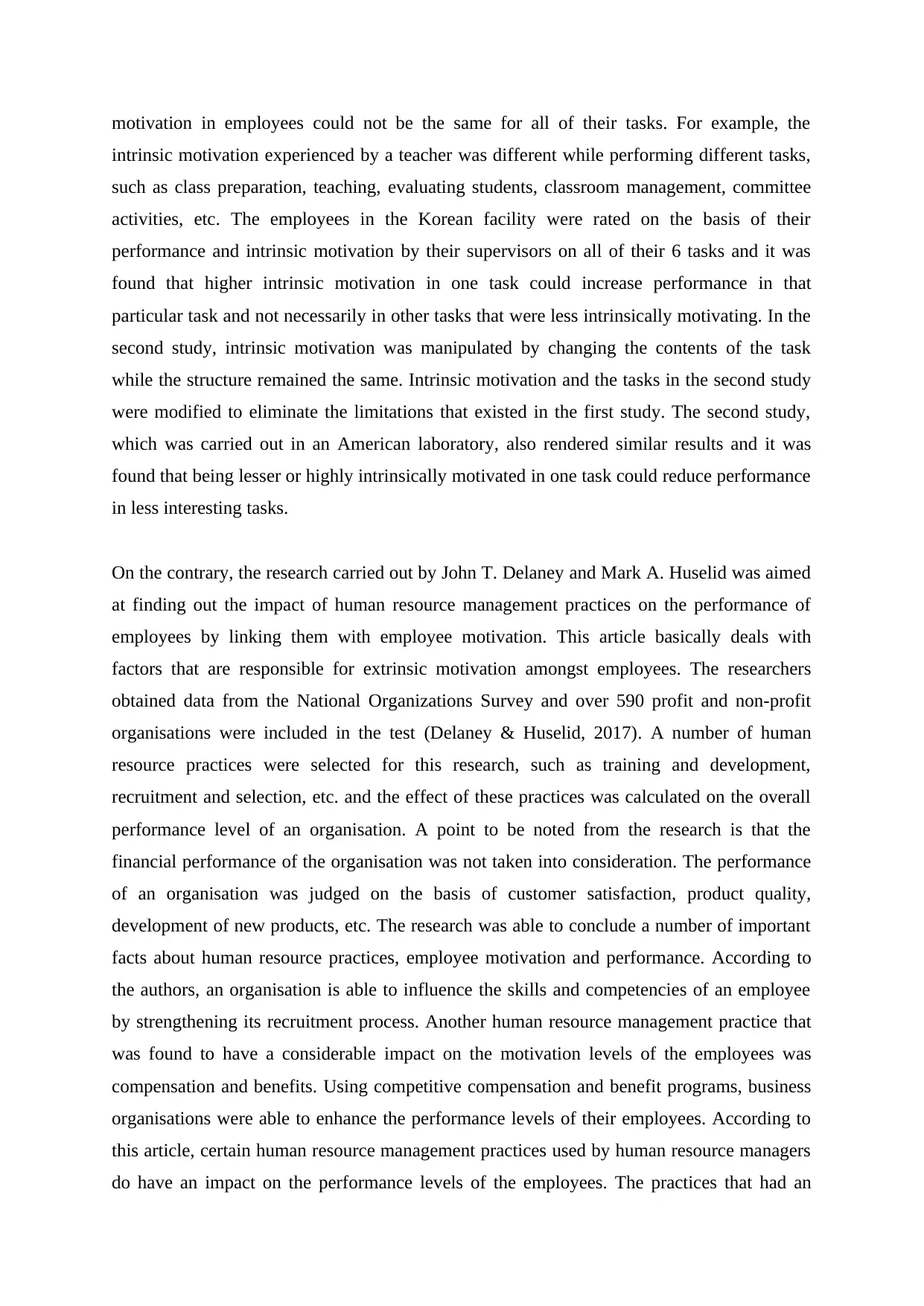
motivation in employees could not be the same for all of their tasks. For example, the
intrinsic motivation experienced by a teacher was different while performing different tasks,
such as class preparation, teaching, evaluating students, classroom management, committee
activities, etc. The employees in the Korean facility were rated on the basis of their
performance and intrinsic motivation by their supervisors on all of their 6 tasks and it was
found that higher intrinsic motivation in one task could increase performance in that
particular task and not necessarily in other tasks that were less intrinsically motivating. In the
second study, intrinsic motivation was manipulated by changing the contents of the task
while the structure remained the same. Intrinsic motivation and the tasks in the second study
were modified to eliminate the limitations that existed in the first study. The second study,
which was carried out in an American laboratory, also rendered similar results and it was
found that being lesser or highly intrinsically motivated in one task could reduce performance
in less interesting tasks.
On the contrary, the research carried out by John T. Delaney and Mark A. Huselid was aimed
at finding out the impact of human resource management practices on the performance of
employees by linking them with employee motivation. This article basically deals with
factors that are responsible for extrinsic motivation amongst employees. The researchers
obtained data from the National Organizations Survey and over 590 profit and non-profit
organisations were included in the test (Delaney & Huselid, 2017). A number of human
resource practices were selected for this research, such as training and development,
recruitment and selection, etc. and the effect of these practices was calculated on the overall
performance level of an organisation. A point to be noted from the research is that the
financial performance of the organisation was not taken into consideration. The performance
of an organisation was judged on the basis of customer satisfaction, product quality,
development of new products, etc. The research was able to conclude a number of important
facts about human resource practices, employee motivation and performance. According to
the authors, an organisation is able to influence the skills and competencies of an employee
by strengthening its recruitment process. Another human resource management practice that
was found to have a considerable impact on the motivation levels of the employees was
compensation and benefits. Using competitive compensation and benefit programs, business
organisations were able to enhance the performance levels of their employees. According to
this article, certain human resource management practices used by human resource managers
do have an impact on the performance levels of the employees. The practices that had an
intrinsic motivation experienced by a teacher was different while performing different tasks,
such as class preparation, teaching, evaluating students, classroom management, committee
activities, etc. The employees in the Korean facility were rated on the basis of their
performance and intrinsic motivation by their supervisors on all of their 6 tasks and it was
found that higher intrinsic motivation in one task could increase performance in that
particular task and not necessarily in other tasks that were less intrinsically motivating. In the
second study, intrinsic motivation was manipulated by changing the contents of the task
while the structure remained the same. Intrinsic motivation and the tasks in the second study
were modified to eliminate the limitations that existed in the first study. The second study,
which was carried out in an American laboratory, also rendered similar results and it was
found that being lesser or highly intrinsically motivated in one task could reduce performance
in less interesting tasks.
On the contrary, the research carried out by John T. Delaney and Mark A. Huselid was aimed
at finding out the impact of human resource management practices on the performance of
employees by linking them with employee motivation. This article basically deals with
factors that are responsible for extrinsic motivation amongst employees. The researchers
obtained data from the National Organizations Survey and over 590 profit and non-profit
organisations were included in the test (Delaney & Huselid, 2017). A number of human
resource practices were selected for this research, such as training and development,
recruitment and selection, etc. and the effect of these practices was calculated on the overall
performance level of an organisation. A point to be noted from the research is that the
financial performance of the organisation was not taken into consideration. The performance
of an organisation was judged on the basis of customer satisfaction, product quality,
development of new products, etc. The research was able to conclude a number of important
facts about human resource practices, employee motivation and performance. According to
the authors, an organisation is able to influence the skills and competencies of an employee
by strengthening its recruitment process. Another human resource management practice that
was found to have a considerable impact on the motivation levels of the employees was
compensation and benefits. Using competitive compensation and benefit programs, business
organisations were able to enhance the performance levels of their employees. According to
this article, certain human resource management practices used by human resource managers
do have an impact on the performance levels of the employees. The practices that had an
Paraphrase This Document
Need a fresh take? Get an instant paraphrase of this document with our AI Paraphraser
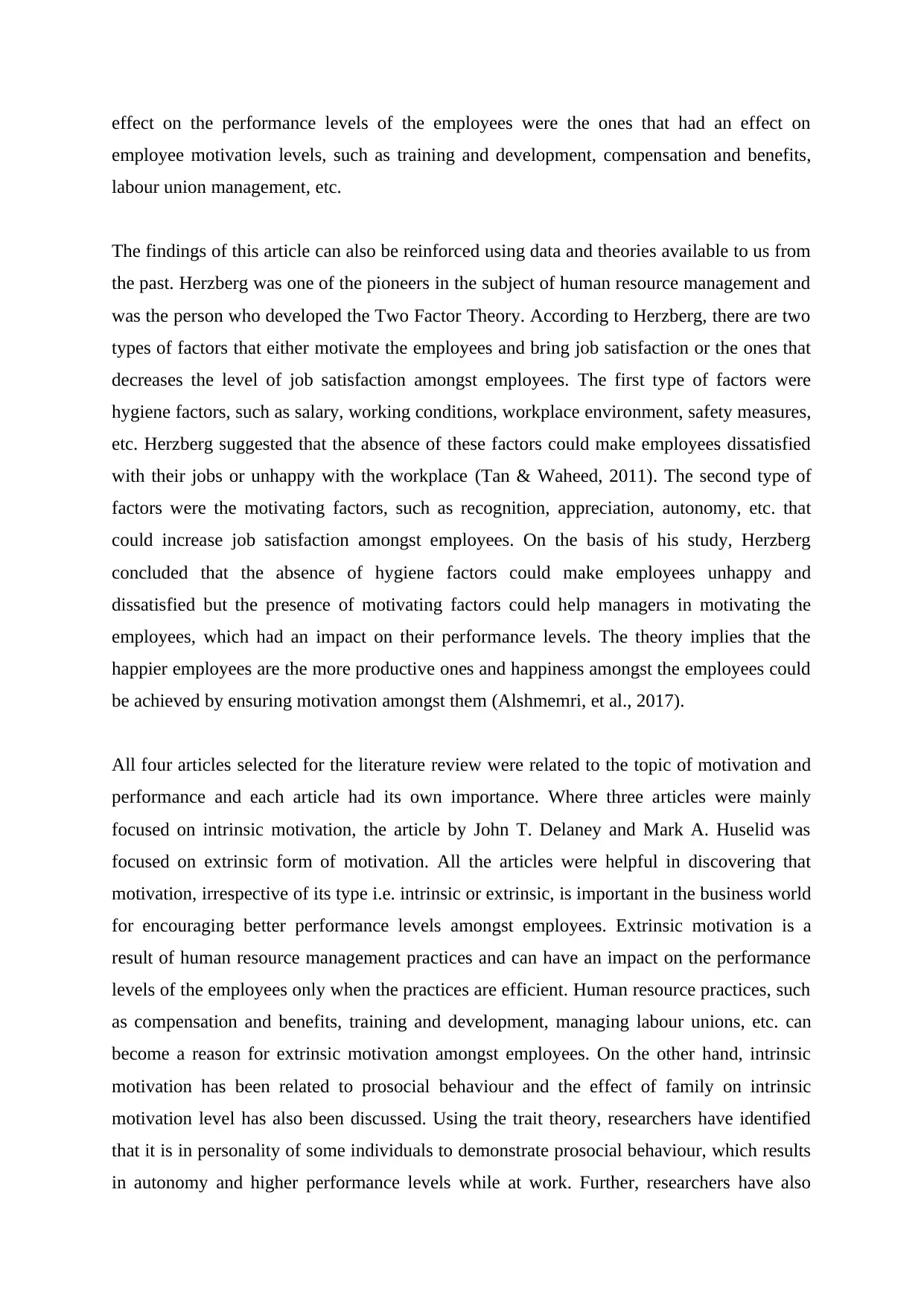
effect on the performance levels of the employees were the ones that had an effect on
employee motivation levels, such as training and development, compensation and benefits,
labour union management, etc.
The findings of this article can also be reinforced using data and theories available to us from
the past. Herzberg was one of the pioneers in the subject of human resource management and
was the person who developed the Two Factor Theory. According to Herzberg, there are two
types of factors that either motivate the employees and bring job satisfaction or the ones that
decreases the level of job satisfaction amongst employees. The first type of factors were
hygiene factors, such as salary, working conditions, workplace environment, safety measures,
etc. Herzberg suggested that the absence of these factors could make employees dissatisfied
with their jobs or unhappy with the workplace (Tan & Waheed, 2011). The second type of
factors were the motivating factors, such as recognition, appreciation, autonomy, etc. that
could increase job satisfaction amongst employees. On the basis of his study, Herzberg
concluded that the absence of hygiene factors could make employees unhappy and
dissatisfied but the presence of motivating factors could help managers in motivating the
employees, which had an impact on their performance levels. The theory implies that the
happier employees are the more productive ones and happiness amongst the employees could
be achieved by ensuring motivation amongst them (Alshmemri, et al., 2017).
All four articles selected for the literature review were related to the topic of motivation and
performance and each article had its own importance. Where three articles were mainly
focused on intrinsic motivation, the article by John T. Delaney and Mark A. Huselid was
focused on extrinsic form of motivation. All the articles were helpful in discovering that
motivation, irrespective of its type i.e. intrinsic or extrinsic, is important in the business world
for encouraging better performance levels amongst employees. Extrinsic motivation is a
result of human resource management practices and can have an impact on the performance
levels of the employees only when the practices are efficient. Human resource practices, such
as compensation and benefits, training and development, managing labour unions, etc. can
become a reason for extrinsic motivation amongst employees. On the other hand, intrinsic
motivation has been related to prosocial behaviour and the effect of family on intrinsic
motivation level has also been discussed. Using the trait theory, researchers have identified
that it is in personality of some individuals to demonstrate prosocial behaviour, which results
in autonomy and higher performance levels while at work. Further, researchers have also
employee motivation levels, such as training and development, compensation and benefits,
labour union management, etc.
The findings of this article can also be reinforced using data and theories available to us from
the past. Herzberg was one of the pioneers in the subject of human resource management and
was the person who developed the Two Factor Theory. According to Herzberg, there are two
types of factors that either motivate the employees and bring job satisfaction or the ones that
decreases the level of job satisfaction amongst employees. The first type of factors were
hygiene factors, such as salary, working conditions, workplace environment, safety measures,
etc. Herzberg suggested that the absence of these factors could make employees dissatisfied
with their jobs or unhappy with the workplace (Tan & Waheed, 2011). The second type of
factors were the motivating factors, such as recognition, appreciation, autonomy, etc. that
could increase job satisfaction amongst employees. On the basis of his study, Herzberg
concluded that the absence of hygiene factors could make employees unhappy and
dissatisfied but the presence of motivating factors could help managers in motivating the
employees, which had an impact on their performance levels. The theory implies that the
happier employees are the more productive ones and happiness amongst the employees could
be achieved by ensuring motivation amongst them (Alshmemri, et al., 2017).
All four articles selected for the literature review were related to the topic of motivation and
performance and each article had its own importance. Where three articles were mainly
focused on intrinsic motivation, the article by John T. Delaney and Mark A. Huselid was
focused on extrinsic form of motivation. All the articles were helpful in discovering that
motivation, irrespective of its type i.e. intrinsic or extrinsic, is important in the business world
for encouraging better performance levels amongst employees. Extrinsic motivation is a
result of human resource management practices and can have an impact on the performance
levels of the employees only when the practices are efficient. Human resource practices, such
as compensation and benefits, training and development, managing labour unions, etc. can
become a reason for extrinsic motivation amongst employees. On the other hand, intrinsic
motivation has been related to prosocial behaviour and the effect of family on intrinsic
motivation level has also been discussed. Using the trait theory, researchers have identified
that it is in personality of some individuals to demonstrate prosocial behaviour, which results
in autonomy and higher performance levels while at work. Further, researchers have also
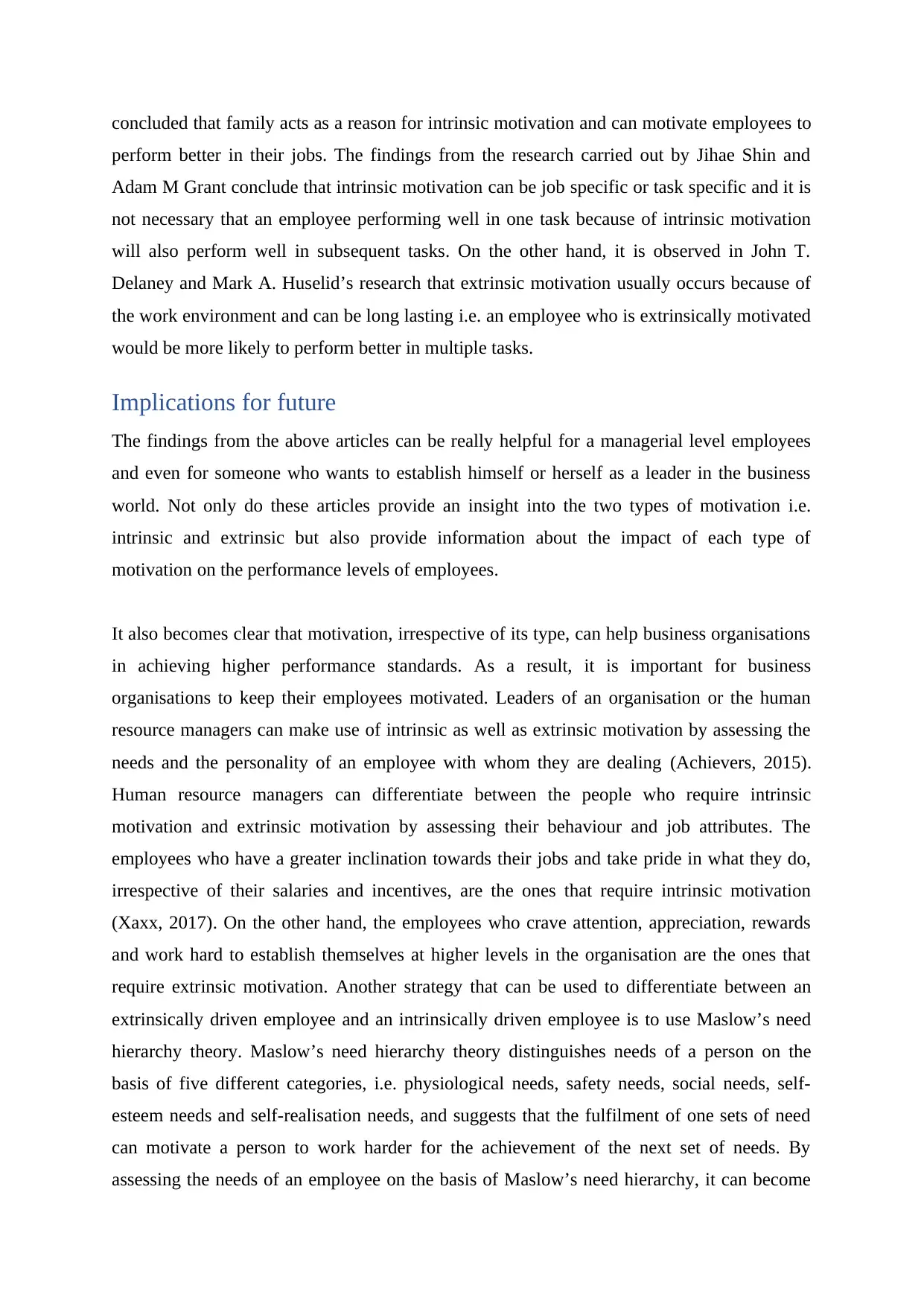
concluded that family acts as a reason for intrinsic motivation and can motivate employees to
perform better in their jobs. The findings from the research carried out by Jihae Shin and
Adam M Grant conclude that intrinsic motivation can be job specific or task specific and it is
not necessary that an employee performing well in one task because of intrinsic motivation
will also perform well in subsequent tasks. On the other hand, it is observed in John T.
Delaney and Mark A. Huselid’s research that extrinsic motivation usually occurs because of
the work environment and can be long lasting i.e. an employee who is extrinsically motivated
would be more likely to perform better in multiple tasks.
Implications for future
The findings from the above articles can be really helpful for a managerial level employees
and even for someone who wants to establish himself or herself as a leader in the business
world. Not only do these articles provide an insight into the two types of motivation i.e.
intrinsic and extrinsic but also provide information about the impact of each type of
motivation on the performance levels of employees.
It also becomes clear that motivation, irrespective of its type, can help business organisations
in achieving higher performance standards. As a result, it is important for business
organisations to keep their employees motivated. Leaders of an organisation or the human
resource managers can make use of intrinsic as well as extrinsic motivation by assessing the
needs and the personality of an employee with whom they are dealing (Achievers, 2015).
Human resource managers can differentiate between the people who require intrinsic
motivation and extrinsic motivation by assessing their behaviour and job attributes. The
employees who have a greater inclination towards their jobs and take pride in what they do,
irrespective of their salaries and incentives, are the ones that require intrinsic motivation
(Xaxx, 2017). On the other hand, the employees who crave attention, appreciation, rewards
and work hard to establish themselves at higher levels in the organisation are the ones that
require extrinsic motivation. Another strategy that can be used to differentiate between an
extrinsically driven employee and an intrinsically driven employee is to use Maslow’s need
hierarchy theory. Maslow’s need hierarchy theory distinguishes needs of a person on the
basis of five different categories, i.e. physiological needs, safety needs, social needs, self-
esteem needs and self-realisation needs, and suggests that the fulfilment of one sets of need
can motivate a person to work harder for the achievement of the next set of needs. By
assessing the needs of an employee on the basis of Maslow’s need hierarchy, it can become
perform better in their jobs. The findings from the research carried out by Jihae Shin and
Adam M Grant conclude that intrinsic motivation can be job specific or task specific and it is
not necessary that an employee performing well in one task because of intrinsic motivation
will also perform well in subsequent tasks. On the other hand, it is observed in John T.
Delaney and Mark A. Huselid’s research that extrinsic motivation usually occurs because of
the work environment and can be long lasting i.e. an employee who is extrinsically motivated
would be more likely to perform better in multiple tasks.
Implications for future
The findings from the above articles can be really helpful for a managerial level employees
and even for someone who wants to establish himself or herself as a leader in the business
world. Not only do these articles provide an insight into the two types of motivation i.e.
intrinsic and extrinsic but also provide information about the impact of each type of
motivation on the performance levels of employees.
It also becomes clear that motivation, irrespective of its type, can help business organisations
in achieving higher performance standards. As a result, it is important for business
organisations to keep their employees motivated. Leaders of an organisation or the human
resource managers can make use of intrinsic as well as extrinsic motivation by assessing the
needs and the personality of an employee with whom they are dealing (Achievers, 2015).
Human resource managers can differentiate between the people who require intrinsic
motivation and extrinsic motivation by assessing their behaviour and job attributes. The
employees who have a greater inclination towards their jobs and take pride in what they do,
irrespective of their salaries and incentives, are the ones that require intrinsic motivation
(Xaxx, 2017). On the other hand, the employees who crave attention, appreciation, rewards
and work hard to establish themselves at higher levels in the organisation are the ones that
require extrinsic motivation. Another strategy that can be used to differentiate between an
extrinsically driven employee and an intrinsically driven employee is to use Maslow’s need
hierarchy theory. Maslow’s need hierarchy theory distinguishes needs of a person on the
basis of five different categories, i.e. physiological needs, safety needs, social needs, self-
esteem needs and self-realisation needs, and suggests that the fulfilment of one sets of need
can motivate a person to work harder for the achievement of the next set of needs. By
assessing the needs of an employee on the basis of Maslow’s need hierarchy, it can become
⊘ This is a preview!⊘
Do you want full access?
Subscribe today to unlock all pages.

Trusted by 1+ million students worldwide
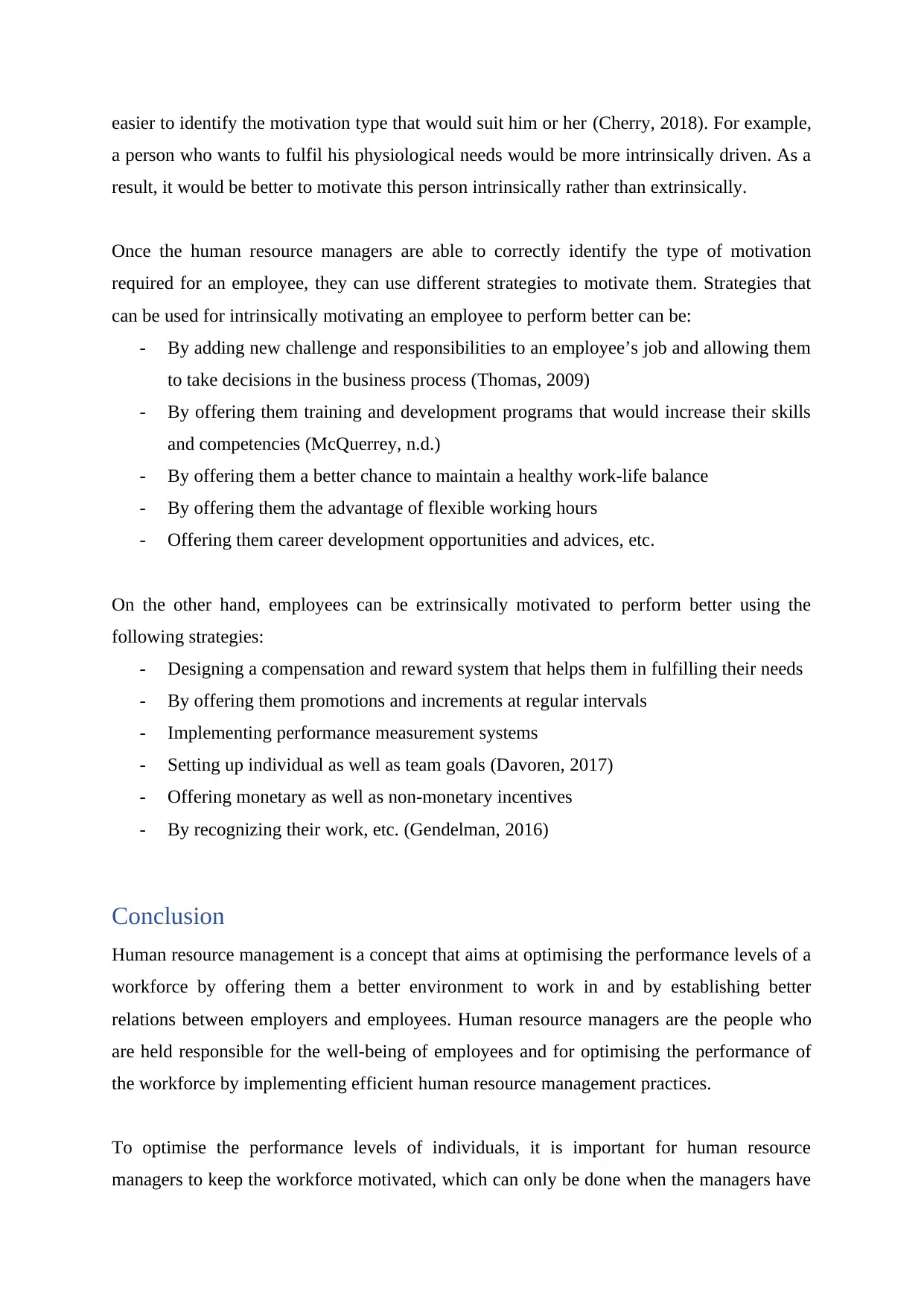
easier to identify the motivation type that would suit him or her (Cherry, 2018). For example,
a person who wants to fulfil his physiological needs would be more intrinsically driven. As a
result, it would be better to motivate this person intrinsically rather than extrinsically.
Once the human resource managers are able to correctly identify the type of motivation
required for an employee, they can use different strategies to motivate them. Strategies that
can be used for intrinsically motivating an employee to perform better can be:
- By adding new challenge and responsibilities to an employee’s job and allowing them
to take decisions in the business process (Thomas, 2009)
- By offering them training and development programs that would increase their skills
and competencies (McQuerrey, n.d.)
- By offering them a better chance to maintain a healthy work-life balance
- By offering them the advantage of flexible working hours
- Offering them career development opportunities and advices, etc.
On the other hand, employees can be extrinsically motivated to perform better using the
following strategies:
- Designing a compensation and reward system that helps them in fulfilling their needs
- By offering them promotions and increments at regular intervals
- Implementing performance measurement systems
- Setting up individual as well as team goals (Davoren, 2017)
- Offering monetary as well as non-monetary incentives
- By recognizing their work, etc. (Gendelman, 2016)
Conclusion
Human resource management is a concept that aims at optimising the performance levels of a
workforce by offering them a better environment to work in and by establishing better
relations between employers and employees. Human resource managers are the people who
are held responsible for the well-being of employees and for optimising the performance of
the workforce by implementing efficient human resource management practices.
To optimise the performance levels of individuals, it is important for human resource
managers to keep the workforce motivated, which can only be done when the managers have
a person who wants to fulfil his physiological needs would be more intrinsically driven. As a
result, it would be better to motivate this person intrinsically rather than extrinsically.
Once the human resource managers are able to correctly identify the type of motivation
required for an employee, they can use different strategies to motivate them. Strategies that
can be used for intrinsically motivating an employee to perform better can be:
- By adding new challenge and responsibilities to an employee’s job and allowing them
to take decisions in the business process (Thomas, 2009)
- By offering them training and development programs that would increase their skills
and competencies (McQuerrey, n.d.)
- By offering them a better chance to maintain a healthy work-life balance
- By offering them the advantage of flexible working hours
- Offering them career development opportunities and advices, etc.
On the other hand, employees can be extrinsically motivated to perform better using the
following strategies:
- Designing a compensation and reward system that helps them in fulfilling their needs
- By offering them promotions and increments at regular intervals
- Implementing performance measurement systems
- Setting up individual as well as team goals (Davoren, 2017)
- Offering monetary as well as non-monetary incentives
- By recognizing their work, etc. (Gendelman, 2016)
Conclusion
Human resource management is a concept that aims at optimising the performance levels of a
workforce by offering them a better environment to work in and by establishing better
relations between employers and employees. Human resource managers are the people who
are held responsible for the well-being of employees and for optimising the performance of
the workforce by implementing efficient human resource management practices.
To optimise the performance levels of individuals, it is important for human resource
managers to keep the workforce motivated, which can only be done when the managers have
Paraphrase This Document
Need a fresh take? Get an instant paraphrase of this document with our AI Paraphraser
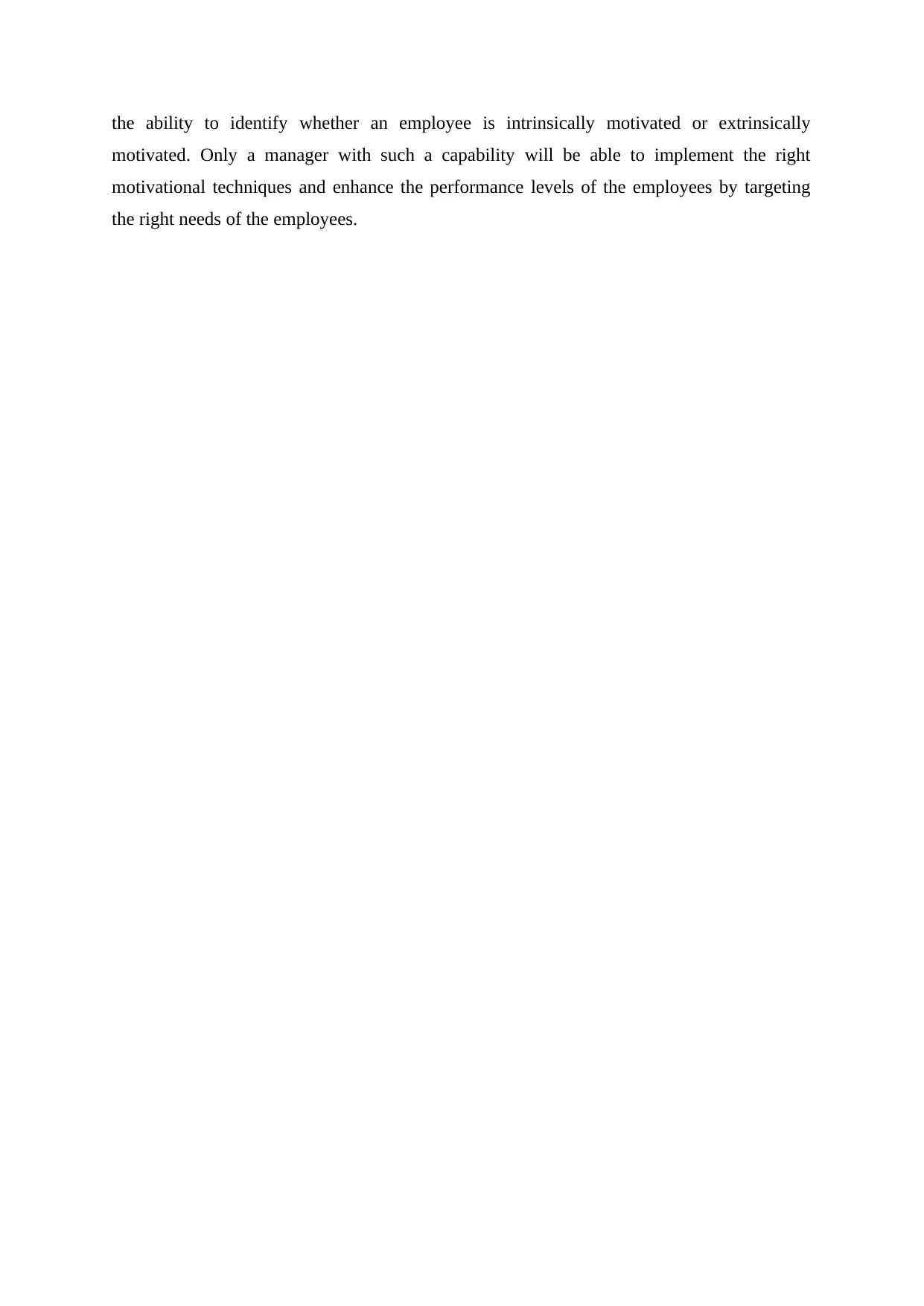
the ability to identify whether an employee is intrinsically motivated or extrinsically
motivated. Only a manager with such a capability will be able to implement the right
motivational techniques and enhance the performance levels of the employees by targeting
the right needs of the employees.
motivated. Only a manager with such a capability will be able to implement the right
motivational techniques and enhance the performance levels of the employees by targeting
the right needs of the employees.
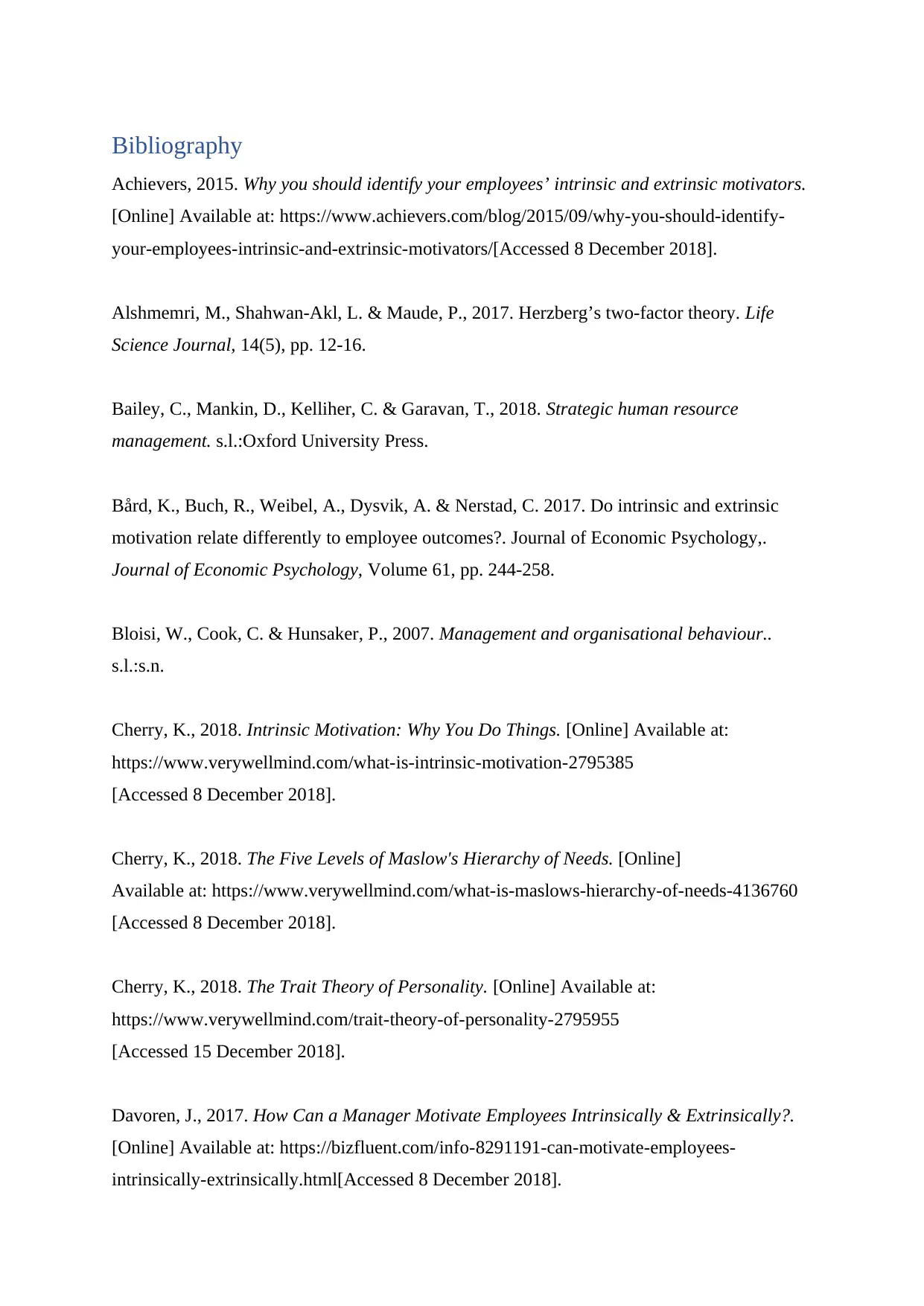
Bibliography
Achievers, 2015. Why you should identify your employees’ intrinsic and extrinsic motivators.
[Online] Available at: https://www.achievers.com/blog/2015/09/why-you-should-identify-
your-employees-intrinsic-and-extrinsic-motivators/[Accessed 8 December 2018].
Alshmemri, M., Shahwan-Akl, L. & Maude, P., 2017. Herzberg’s two-factor theory. Life
Science Journal, 14(5), pp. 12-16.
Bailey, C., Mankin, D., Kelliher, C. & Garavan, T., 2018. Strategic human resource
management. s.l.:Oxford University Press.
Bård, K., Buch, R., Weibel, A., Dysvik, A. & Nerstad, C. 2017. Do intrinsic and extrinsic
motivation relate differently to employee outcomes?. Journal of Economic Psychology,.
Journal of Economic Psychology, Volume 61, pp. 244-258.
Bloisi, W., Cook, C. & Hunsaker, P., 2007. Management and organisational behaviour..
s.l.:s.n.
Cherry, K., 2018. Intrinsic Motivation: Why You Do Things. [Online] Available at:
https://www.verywellmind.com/what-is-intrinsic-motivation-2795385
[Accessed 8 December 2018].
Cherry, K., 2018. The Five Levels of Maslow's Hierarchy of Needs. [Online]
Available at: https://www.verywellmind.com/what-is-maslows-hierarchy-of-needs-4136760
[Accessed 8 December 2018].
Cherry, K., 2018. The Trait Theory of Personality. [Online] Available at:
https://www.verywellmind.com/trait-theory-of-personality-2795955
[Accessed 15 December 2018].
Davoren, J., 2017. How Can a Manager Motivate Employees Intrinsically & Extrinsically?.
[Online] Available at: https://bizfluent.com/info-8291191-can-motivate-employees-
intrinsically-extrinsically.html[Accessed 8 December 2018].
Achievers, 2015. Why you should identify your employees’ intrinsic and extrinsic motivators.
[Online] Available at: https://www.achievers.com/blog/2015/09/why-you-should-identify-
your-employees-intrinsic-and-extrinsic-motivators/[Accessed 8 December 2018].
Alshmemri, M., Shahwan-Akl, L. & Maude, P., 2017. Herzberg’s two-factor theory. Life
Science Journal, 14(5), pp. 12-16.
Bailey, C., Mankin, D., Kelliher, C. & Garavan, T., 2018. Strategic human resource
management. s.l.:Oxford University Press.
Bård, K., Buch, R., Weibel, A., Dysvik, A. & Nerstad, C. 2017. Do intrinsic and extrinsic
motivation relate differently to employee outcomes?. Journal of Economic Psychology,.
Journal of Economic Psychology, Volume 61, pp. 244-258.
Bloisi, W., Cook, C. & Hunsaker, P., 2007. Management and organisational behaviour..
s.l.:s.n.
Cherry, K., 2018. Intrinsic Motivation: Why You Do Things. [Online] Available at:
https://www.verywellmind.com/what-is-intrinsic-motivation-2795385
[Accessed 8 December 2018].
Cherry, K., 2018. The Five Levels of Maslow's Hierarchy of Needs. [Online]
Available at: https://www.verywellmind.com/what-is-maslows-hierarchy-of-needs-4136760
[Accessed 8 December 2018].
Cherry, K., 2018. The Trait Theory of Personality. [Online] Available at:
https://www.verywellmind.com/trait-theory-of-personality-2795955
[Accessed 15 December 2018].
Davoren, J., 2017. How Can a Manager Motivate Employees Intrinsically & Extrinsically?.
[Online] Available at: https://bizfluent.com/info-8291191-can-motivate-employees-
intrinsically-extrinsically.html[Accessed 8 December 2018].
⊘ This is a preview!⊘
Do you want full access?
Subscribe today to unlock all pages.

Trusted by 1+ million students worldwide
1 out of 18
Related Documents
Your All-in-One AI-Powered Toolkit for Academic Success.
+13062052269
info@desklib.com
Available 24*7 on WhatsApp / Email
![[object Object]](/_next/static/media/star-bottom.7253800d.svg)
Unlock your academic potential
Copyright © 2020–2025 A2Z Services. All Rights Reserved. Developed and managed by ZUCOL.





